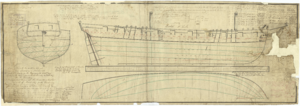HMS Columbine (1806) facts for kids

Columbine
|
|
Quick facts for kids History |
|
|---|---|
| Name | HMS Columbine |
| Ordered | 12 November 1805 |
| Builder | Balthazar & Edward Admas, Bucklers Hard |
| Laid down | January 1806 |
| Launched | 16 July 1806 |
| Fate | Wrecked 1824 |
| General characteristics | |
| Type | Cruizer-class brig-sloop |
| Tonnage | 385 85⁄94 (bm) |
| Length |
|
| Beam | 30 ft 8 in (9.3 m) |
| Depth of hold | 12 ft 10 in (3.9 m) |
| Sail plan | Brig rigged |
| Complement | 121 |
| Armament |
|
HMS Columbine was a type of warship called a Cruizer-class. It was launched in 1806. This ship served the Royal Navy during the Napoleonic Wars. Columbine sailed in many different places around the world. These included North America, the Mediterranean, and the West Indies. Sadly, the ship was wrecked in 1824 off the coast of Greece.
Contents
Life at Sea: HMS Columbine
Early Adventures and Commanders
Commander James Bradshaw was the first captain of Columbine in August 1806. He sailed the ship to Halifax, Canada. In July 1807, Columbine brought important news to Halifax. This news was about a naval incident between a British and an American ship.
In April 1808, Lieutenant George Hills became the new commander of Columbine. He replaced Commander Bradshaw.
A Difficult Time: Mutiny on Board
On August 1, 1809, a serious event happened on Columbine. Some sailors refused to follow orders. This is called a mutiny. Twenty-two sailors left the ship. Twenty-three others faced a special naval trial called a court martial. Some crew members were found guilty. They were sent away to a far-off place called New South Wales. After this, Commander Hill sailed Columbine back to Britain. The ship was taken out of service in March 1810.
New Missions in the Mediterranean
In July 1810, Commander James Collins took charge of Columbine. He sailed the ship to the Mediterranean Sea. On October 21, 1810, he was promoted to a higher rank. Commander William Shepheard then became the ship's captain in November.
Capturing Enemy Ships
Columbine was very active in the Mediterranean. On June 4, 1811, near Saint Lucar, Columbine's smaller boats captured a French ship. This French ship was called Guadalquiver. It had two small cannons and six swivel guns. It also had a crew of 42 men.
Later, Lieutenant George Augustus Westphal temporarily commanded Columbine. On September 30, 1811, Columbine's boats captured two French privateer ships. These ships were hiding near shore batteries at Chipiona. Commander Shepheard returned to Columbine after about three months.
Helping Troops in Spain
In October 1811, Columbine helped transport soldiers. The ship, along with Stately and Tuscan, carried British troops. They went to Tarifa, Spain. These soldiers were sent to help Spanish forces fighting against the French army. The troops landed on October 18. The next day, the French tried to advance along the coast. But fire from the British ships forced them to retreat.
Service off Portugal and the West Indies
In November 1811, Commander Richard H. Muddle became the new captain. Under his command, Columbine spent 1812 and 1813 off the coast of Portugal.
On August 11, 1812, Columbine stopped an American ship called Louisa. This ship was later taken as a prize. This meant its goods could be sold, and the money shared among the crew.
On April 14, 1813, Columbine helped recapture a ship called Active. It shared this capture with Magicienne.
In 1814, Columbine was in the West Indies. There, Columbine and the frigate Ister captured a ship involved in the slave trade. This ship was called Atrivedo. They rescued many people who had been forced into slavery. This included 90 men, 71 women, and 111 children.
On March 16, Columbine was in the Demerara River. Commander Muddle praised the master of a merchant ship called Liverpool. This ship had fought off a famous American privateer named Snap Dragon. Liverpool had successfully defended itself in a five-hour battle.
Later Years and Shipwreck
Between 1818 and 1820, Columbine underwent repairs in Plymouth. Then, from April to September 1823, it was prepared for sea duty again. Commander the Honourable Charles Abbot took command in September. He sailed Columbine to the Mediterranean, where it operated off the coast of Greece.
On November 26, 1823, Columbine found and destroyed a pirate ship. The crew of 25 pirates were removed from their vessel. Columbine also captured another pirate ship that was later sold.
The Final Voyage and Loss
On January 25, 1824, Columbine was unfortunately wrecked. It hit rocks near Sapientza Island, off the southern coast of Greece. The ship had sailed from Corfu on January 15 and arrived at the island on January 19.
Commander Abbot had anchored the ship off Port Longue. On the night of January 24, the weather became very bad. The ship's anchor did not hold it securely. As a result, Columbine was pushed onto a reef and sank. Luckily, all the crew members survived. They managed to climb onto the rocks.
A naval court later looked into the incident. Commander Abbot and the ship's master, James Atkinson, were criticized. They were told off for only using one anchor and not being ready for the bad weather. Another report said that two crew members were lost. The local Turkish garrison, even though they didn't have much food themselves, sent supplies to the crew. This helped them survive until another British ship, Alacrity, could rescue them.

